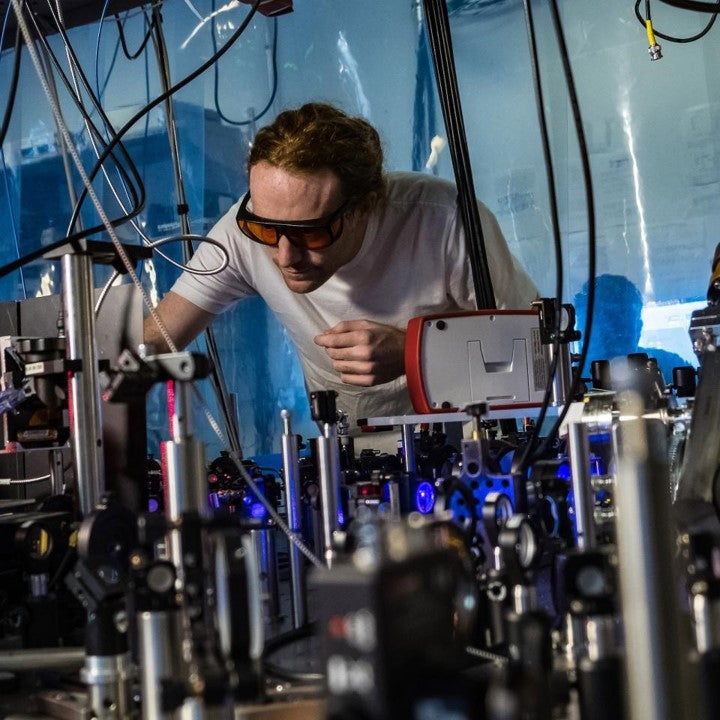Physics and Astronomy
Research Advisor: Thomas Killian
When we think about lasers, one of the first things that comes to mind might be ray guns that melt metal and burn holes in enemy droids. The idea of cooling matter down with lasers, then, might seem counterintuitive, but so does a lot of physics at the quantum level.
Joe Whalen’s research in Tom Killian’s lab starts with bringing atoms down to incredibly cold temperatures. We learn in early chemistry classes that temperature is a measure of random motions among particles: the greater the variance in the velocities of the particles, the greater the temperature. Making the velocities of a collection of particles more uniform therefore corresponds to decreasing the temperature of those particles.
The laser comes into play because absorbing a photon of light changes the momentum of a particle. Atoms only absorb certain wavelengths of photons, and the wavelength that an atom “sees” depends on whether the atom is moving towards or away from a light source. Much like a siren sounds higher-pitched when an ambulance is moving towards you and lower-pitched when the ambulance is moving away, particles moving towards the laser source experience a shorter wavelength than those moving away.
Researchers can tune the wavelength so that only an atom moving towards the laser experiences photons that it can absorb, while an atom moving away or neither towards nor away does not interact with the light. When the atom absorbs the photon, it slows down. Laser cooling generates a net slowing of the atoms moving towards the laser, which directs the velocities of the atoms in the opposite direction. By making the velocities more uniform, laser cooling decreases temperature.
Using this technique, Whalen takes atoms of strontium down to temperatures very close to absolute zero. Under these conditions, matter exhibits exotic behavior. Because the wavelength of a particle decreases with increasing momentum, very cold atoms that don’t move around as fast have longer wavelengths. Combined with the fact that atoms get closer together at lower temperatures, this means that atoms at absolute zero have wavelengths comparable in size to the distance between two atoms. “You enter a regime where the wavelike nature of particles is dominant.
Researchers exploit this property of ultracold atomic systems to study many different aspects of quantum physics. Whalen’s research focuses on a bizarre structure called a Rydberg molecule, which can be hundreds or thousands of times larger than an ordinary diatomic molecule.
“We take this cold sample and we promote one or maybe a few atoms to a very highly-excited electronic state called a Rydberg state. In a Rydberg state, the electron is now very far away from its parent nucleus and very weakly-bound.”
The energetic electron whizzes around in the ultracold gas and collides with other atoms in the gas to “create an attractive potential that the other atoms feel,” said Whalen. The attractive potential weakly binds atoms together into groups so “extraordinarily delicate and sensitive that they can’t really exist anywhere else in the universe except in our chamber and places like it,” said Whalen. “Even in deep space, the thermal energy of the particles would tear the Rydberg molecules apart.”
Researchers in the Killian group can control the size of their Rydberg molecules by controlling the energy their laser imparts to the strontium electrons. Whalen currently investigates how he can use this as a sort of ruler to measure distances in quantum systems.
“We’re developing a method of probing quantum states at length scales that have never been accessible until this technique,” he explained. This is important because the solutions to the equations describing quantum mechanical systems more complex than a hydrogen atom can only be approximated, and complicated systems like lattices of metal atoms present huge challenges even for computational approximation. Because physicists can’t calculate the solutions, they must find ways to determine them experimentally.
While quantum mechanics may feel inaccessible to most of us living in the macroscopic, classical physics world, Joe Whalen gets to be an exception “I see quantum mechanics every day, and I’m like ‘I made that quantum mechanics happen.’” In more ways than one, it doesn’t get much cooler than that.

